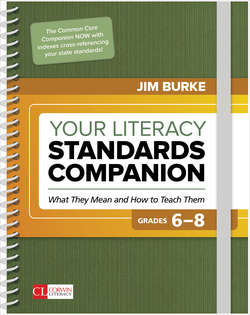Читать книгу Your Literacy Standards Companion, Grades 6-8 - Jim Burke - Страница 25
На сайте Литреса книга снята с продажи.
ОглавлениеCollege and Career Readiness Anchor Standards for Reading 6–8
Source: Common Core State Standards
The grades 6–12 standards on the following pages define what students should understand and be able to do by the end of each grade. They correspond to the College and Career Readiness (CCR) anchor standards by number. The CCR and grade-specific standards are necessary complements—the former providing broad standards, the latter providing additional specificity—that together define the skills and understandings that all students must demonstrate.
Key Ideas and Details
1. Read closely to determine what the text says explicitly and to make logical inferences from it; cite specific textual evidence when writing or speaking to support conclusions drawn from the text.
2. Determine central ideas or themes of a text and analyze their development; summarize the key supporting details and ideas.
3. Analyze how and why individuals, events, and ideas develop and interact over the course of a text.
Craft and Structure
4. Interpret words and phrases as they are used in a text, including determining technical, connotative, and figurative meanings, and analyze how specific word choices shape meaning or tone.
5. Analyze the structure of texts, including how specific sentences, paragraphs, and larger portions of the text (e.g., a section, chapter, scene, or stanza) relate to one another and the whole.
6. Assess how point of view or purpose shapes the content and style of a text.
Integration of Knowledge and Ideas
7. Integrate and evaluate content presented in diverse formats and media, including visually and quantitatively, as well as in words.*
8. Delineate and evaluate the argument and specific claims in a text, including the validity of the reasoning as well as the relevance and sufficiency of the evidence.
9. Analyze how two or more texts address similar themes or topics to build knowledge or to compare the approaches the authors take.
* Please consult the full Common Core State Standards document (and all updates and appendices) at http://www.corestandards.org/ELA-Literacy. See “Research to Build Knowledge” in the Writing section and “Comprehension and Collaboration” in the Speaking and Listening section for additional standards relevant to gathering, assessing, and applying information from print and digital sources.
Range of Reading and Level of Text Complexity
10. Read and comprehend complex literary and informational texts independently and proficiently.
Note on Range and Content of Student Reading
To become college and career ready, students must grapple with works of exceptional craft and thought whose range extends across genres, cultures, and centuries. Such works offer profound insights into the human condition and serve as models for students’ thinking and writing. Along with high-quality contemporary works, these texts should be chosen from among seminal U.S. documents, the classics of American literature, and the timeless dramas of Shakespeare. Through wide and deep reading of literature and literary nonfiction of steadily increasing sophistication, students gain a reservoir of literary and cultural knowledge, references, and images; the ability to evaluate intricate arguments; and the capacity to surmount the challenges posed by complex texts.
Source: Copyright © 2010. National Governors Association Center for Best Practices and Council of Chief State School Officers. All rights reserved.
